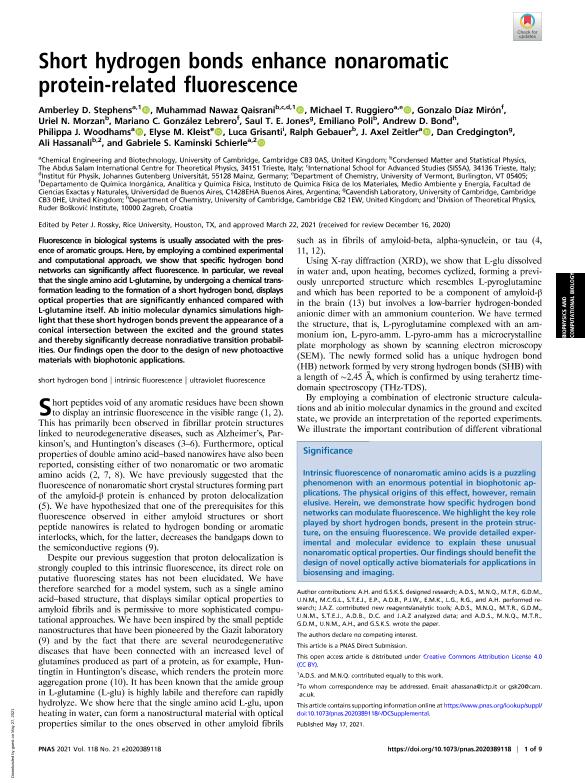Artículo
Short hydrogen bonds enhance nonaromatic protein-related fluorescence
Stephens, Amberley D.; Qaisrani, Muhammad Nawaz; Ruggiero, Michael T.; Díaz Mirón, Gonzalo ; Morzan, Uriel
; Morzan, Uriel ; González Lebrero, Mariano Camilo
; González Lebrero, Mariano Camilo ; Jones, Saul T. E.; Poli, Emiliano; Bond, Andrew D.; Woodhams, Philippa J.; Kleist, Elyse M.; Grisanti, Luca; Gebauer, Ralph; Zeitler, J. Axel; Abadie, Nicolás Daniel
; Jones, Saul T. E.; Poli, Emiliano; Bond, Andrew D.; Woodhams, Philippa J.; Kleist, Elyse M.; Grisanti, Luca; Gebauer, Ralph; Zeitler, J. Axel; Abadie, Nicolás Daniel ; Hassanali, Ali; Kaminski Schierle, Gabriele S.
; Hassanali, Ali; Kaminski Schierle, Gabriele S.
 ; Morzan, Uriel
; Morzan, Uriel ; González Lebrero, Mariano Camilo
; González Lebrero, Mariano Camilo ; Jones, Saul T. E.; Poli, Emiliano; Bond, Andrew D.; Woodhams, Philippa J.; Kleist, Elyse M.; Grisanti, Luca; Gebauer, Ralph; Zeitler, J. Axel; Abadie, Nicolás Daniel
; Jones, Saul T. E.; Poli, Emiliano; Bond, Andrew D.; Woodhams, Philippa J.; Kleist, Elyse M.; Grisanti, Luca; Gebauer, Ralph; Zeitler, J. Axel; Abadie, Nicolás Daniel ; Hassanali, Ali; Kaminski Schierle, Gabriele S.
; Hassanali, Ali; Kaminski Schierle, Gabriele S.
Fecha de publicación:
05/2021
Editorial:
National Academy of Sciences
Revista:
Proceedings of the National Academy of Sciences of The United States of America
ISSN:
0027-8424
Idioma:
Inglés
Tipo de recurso:
Artículo publicado
Clasificación temática:
Resumen
Fluorescence in biological systems is usually associated with the presence of aromatic groups. Here, by employing a combined experimental and computational approach, we show that specific hydrogen bond networks can significantly affect fluorescence. In particular, we reveal that the single amino acid L-glutamine, by undergoing a chemical transformation leading to the formation of a short hydrogen bond, displays optical properties that are significantly enhanced compared with L-glutamine itself. Ab initio molecular dynamics simulations highlight that these short hydrogen bonds prevent the appearance of a conical intersection between the excited and the ground states and thereby significantly decrease nonradiative transition probabilities. Our findings open the door to the design of new photoactive materials with biophotonic applications.
Palabras clave:
INTRINSIC FLUORESCENCE
,
SHORT HYDROGEN BOND
,
ULTRAVIOLET FLUORESCENCE
Archivos asociados
Licencia
Identificadores
Colecciones
Articulos(INQUIMAE)
Articulos de INST.D/QUIM FIS D/L MATERIALES MEDIOAMB Y ENERGIA
Articulos de INST.D/QUIM FIS D/L MATERIALES MEDIOAMB Y ENERGIA
Citación
Stephens, Amberley D.; Qaisrani, Muhammad Nawaz; Ruggiero, Michael T.; Díaz Mirón, Gonzalo; Morzan, Uriel; et al.; Short hydrogen bonds enhance nonaromatic protein-related fluorescence; National Academy of Sciences; Proceedings of the National Academy of Sciences of The United States of America; 118; 21; 5-2021
Compartir
Altmétricas



